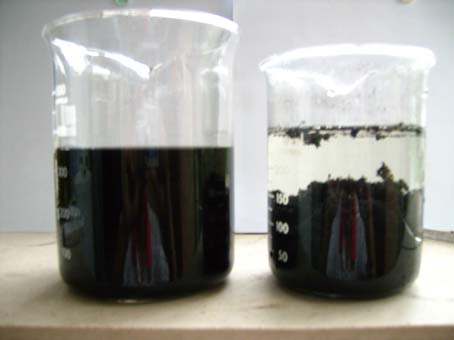
Solution of printing and dyeing wastewater decolorizing agent
April 13, 2018
Printing and dyeing wastewater refers to the waste water discharged from cotton, wool and chemical fiber during pretreatment, dyeing, printing and finishing. The composition of the printing and dyeing wastewater is complex, mainly using aromatic and heterocyclic compounds as the parent, and with the chromogenic groups (such as - N N - N O) and polar groups (such as - SO3Na, - OH, - NH2). Dye molecules, including SO3H, COOH, and OH groups such as reactive dyes and neutral dyes, can form hydrogen bonds with water molecules, such as reactive dyes and neutral dyes, and dye molecules can be completely dissolved in waste water; dyes containing or lacking hydrophilic groups such as SO3H, COOH, OH and other hydrophilic groups exist in the form of hydrophobic suspended particles in the wastewater; containing a small amount of hydrophobic groups A group of dye molecules with large molecular weight or completely without hydrophilic groups exist in colloid form in water.
Printing and dyeing wastewater often has the following auxiliaries: (1) neutral electrolytes such as NaCl, Na2SO4, etc.; (2) acid and alkali regulators such as HCl, NaOH or Na2CO3; (3) surfactant; (4) puffing agents such as urea; (5) adhesives such as modified starch, urea formaldehyde resin, polyvinyl alcohol, and other stabilizers such as phosphates. Printing and dyeing wastewater has complex components, large chromaticity, high COD, and develops towards the direction of oxidation resistance and biodegradation. It has become an important source of pollution in various large waters in China. At present, the decolorization of hydrophobic or insoluble dye wastewater has been basically solved, and the difficulty lies in the decolorization of many hydrophilic or water-soluble dye wastewater, which is also one of the most difficult industrial wastewater to be treated at present.
But in practical application, it is necessary to make clear the color / dye types in the wastewater and the acid base value of sewage. In order to choose the appropriate decolorization scheme, we can get twice the result with half the effort. There are two ways to operate simultaneously, such as oxidation, condensation, reduction and condensation, chelation + condensation and adsorption.
As for the chemical raw materials for sewage treatment, there are many kinds of reducers oxidants that cannot be detailed. Coagulants are mainly aluminum sulfate / alum / polyaluminum chloride and polymer bridging agents. There are many chelating agents, so we need to study the selection of sewage components. The main adsorbents are activated carbon, porous inorganic adsorbent or polymer adsorbent.

Copyright © Henan Yuanbo Environmental Protection Technology Co., LTD. All rights reserved Powered by MetInfo



